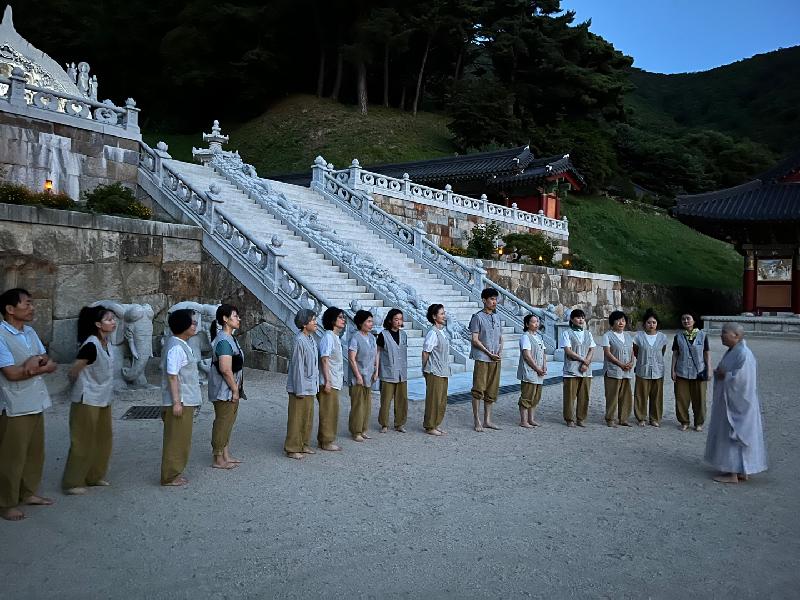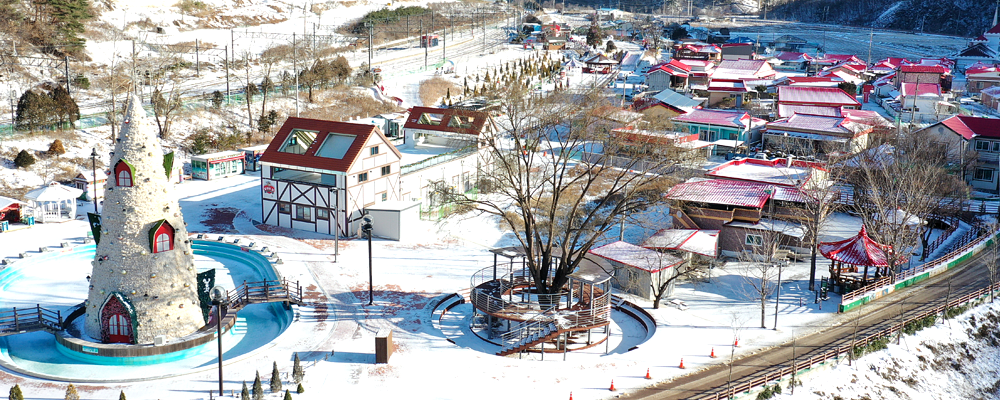
This is a traditional Korean retreat program at a historic Buddhist temple. Far from the stress of city life, you will rest in a quiet temple surrounded by forest and learn how to calm your mind through meditation and daily Buddhist rituals. You will practice seated meditation, walking meditation, and chanting, which help you relax and let go of worries. Take time in nature to look within, reflect on your life, and find a new sense of direction.

1. A Time to Heal Your Mind
At this temple, you will spend time with Buddhist monks who guide you in understanding and healing your mind. The monks say ‘that when your mind is restless, even small things can hurt you, and relationships become difficult’. Here, surrounded by nature, you will learn how to relax your mind and let go of stress and pain. As your mind becomes calmer, you will also gain the ability to understand and care for others more deeply.
2. Positive Change Through Buddhist Practice
In this program, you will experience temple life as a way to strengthen your inner self. Practices like walking meditation, 108 prostrations, seated meditation, and even temple chores help you find focus and clarity. These activities naturally calm your mind and increase concentration, making it easier to fully engage with your daily life. Through this time, you can rethink your life’s direction and gain the strength to move forward with purpose and peace.
3. Deep Rest Through Healthy Living in Nature
This mountain temple in deep forest offers a complete break from city noise and busyness. Fresh air, a balanced daily routine, and nutritious temple food help your body and mind recover naturally. Korean temple food is simple yet rich in flavor, made with natural ingredients and unique methods that nourish both body and spirit. Sharing tea and conversation while looking at the beautiful scenery is more than a break—it is a moment of healing and a chance to understand Korean culture more deeply. Take a slow breath and regain the energy to face new challenges ahead.
This is a temple stay program held at a peaceful Buddhist temple in Bonghwa, Gyeongsangbuk-do, South Korea. In this serene natural setting, you will practice meditation, take peaceful walks through the forest, help with temple chores, and engage in meaningful conversations with monks. Through these experiences, you will learn to calm your mind and find peace, letting go of stress and emotional burdens. At the end of your stay, you may feel refreshed both physically and mentally.
Main Activities
Meditation
Spend time in quiet meditation, closing your eyes and focusing on your breathing. Breathing slowly in nature helps calm the mind and reduce anxiety. By practicing every day, you can train your mind to stay relaxed and improve your concentration.
Tea Time with a Monk
Enjoy a warm cup of tea while having a relaxing conversation with a monk. This time allows you to freely share your thoughts or concerns in a calm atmosphere. The monk’s wisdom may offer new perspective or guidance, and sometimes help you find your own answers.
Cham Seon
Sit quietly on a cushion and focus deeply on your breath and mind. As you let go of distracting thoughts, you may feel your mind become clear and centered. Seated meditation helps reduce internal noise caused by stress and worry, allowing you to make clearer decisions in your daily life.
Ye Bul
In front of the Buddha statue, you will take part in ceremonial chanting to show respect and reflect on yourself. Through songs, chants, and bowing, you learn gratitude, mindfulness, and humility, while experiencing a sense of unity with the temple community. This activity helps deepen your respect for yourself, others, and nature.
Temple Chores (Unryeok)
You will work together with others to clean and care for the temple and its natural surroundings. Tasks such as sweeping the yard, tending to plants, or organizing shared spaces may seem simple, but doing them mindfully can bring great peace and clarity. This shared effort encourages gratitude, teamwork, and a sense of belonging.
Balwoo Gongyang
Experience a traditional Buddhist meal ritual. You will quietly receive food, eat mindfully, and reflect on the meaning of the meal. This slow, thoughtful eating practice teaches appreciation, self-control, and respect for food—changing the way you view eating and living.
Program Schedule
During your stay at Temple, surrounded by its beautiful scenery and deep history, you will learn meditation, self-reflection, and the temple way of life.
Day 1 (Orientation)
| Time | Schedule |
| 15:00 – 16:30 | Check-in & rest |
| 16:30 – 17:30 | Temple tour & etiquette briefing |
| 17:30 – 19:00 | Dinner |
| 19:00 – 20:00 | Tea time with a monk |
| 20:00 – 03:00 | Rest & sleep |
Daily Schedule Example
| Time | Schedule |
| 03:00 – 03:20 | Wake up |
| 03:20 – 04:30 | Morning chanting & 108 bows |
| 04:30 – 05:30 | Prayer, meditation, or seated practice |
| 05:30 – 07:30 | Temple chores & breakfast |
| 07:30 – 10:30 | Break & personal practice |
| 10:30 – 13:30 | Temple chores & lunch |
| 13:30 – 16:30 | Rest & personal practice |
| 17:00 – 18:30 | Temple chores & dinner |
| 19:00 – 20:30 | Prayer, meditation, or seated practice |
| 20:30 – 03:00 | Sleep |
* The above schedule is a sample to help you understand the activity. Itinerary may vary depending on local circumstances.
Unique Features of This Project
Explore the Hidden Charms of Korea
Step away from the bustling city of Seoul and discover Korea’s peaceful countryside. Surrounded by mountains and untouched nature, the temple offers a view of Korea’s beauty rarely seen by travelers. Enjoy meals inspired by nature and experience a side of Korea that the city cannot offer.
Relaxation and Self-Reflection
Take time to relax, reflect, and discover a new side of yourself. Meditate and walk in the temple’s tranquil surroundings, calming your mind and reconnecting with your inner balance. This is a rare chance to rest, heal, and focus on personal growth.

Additional Information
- The detailed schedule may change depending on weather and local conditions.
- Please observe temple etiquette.
- Please greet the monks with your hands clasped and a half-bow.
- Please refrain from making loud noises during your stay.
- There is no TV, Wi-Fi, or other modern facilities in the temple.
- Drinking, smoking, and bringing in outside food and drinks are prohibited within the temple.
- There is no English interpreter. Most communication will be in Korean.
- Please turn off or silence your cell phones while staying at the temple.
- Do not promote your religion or lifestyle to others.
- All meals are vegetarian and follow traditional Buddhist customs; eating silently and finishing all food is part of the etiquette.
- Observe the meal times.
Reviews
"It was very helpful and relaxing. I felt like I found a chance to regain peace of mind."
– Im -
"Being away from the city and spending time in nature helped my body and mind feel calm and stable. Everyone at the temple was kind and welcoming, so I felt very comfortable. Through the daily chanting and 108 bows, I had meaningful time to reflect on myself. Thank you so much. I wish everyone enlightenment."
– Lee -
"While experiencing the quietness of mind through meditation, I realized that I had been thinking too much in my daily life. I also learned how important it is to stay focused on what I do every day. I am truly grateful to everyone who prepared and guided this program."
– Yoo -
"This was my first time joining as a Buddhist beginner, but I was deeply moved by the monk’s peaceful and clear teachings. The monk’s effort to teach us even one more thing helped me see Buddhism in a new light. I hope the seeds planted in everyone’s hearts will grow and bear good fruit."
– Jung -
"I will never forget the meditation and moments of letting go, the fresh mountain air in the early morning, the sound of the temple bell, and the monk’s warm and wise teachings."
– Kim -

Detailed Support
General Items for Participants
- Personal toiletries (shampoo, conditioner, body wash), towel, toothbrush, extra clothes, sneakers (comfortable), socks, personal (thermal) water bottle (cup)
*Please bring your own personal items.

Not Included
.png)

Chukseo Temple, where this project takes place, is located at the foot of Mount Munsusan, and its name means “temple where eagles reside.” In Buddhism, the eagle symbolizes wisdom, and the temple represents the Bodhisattva Myriad, embodying immense wisdom. Founded by the Buddhist monk Uisang in the 13th year of King Munmu’s reign, Chukseo Temple was later used as a battlefield by the Righteous Army, which rose up against Japan following the Japan-Korea Treaty of 1915 and the Treaty of 1916. During a suppression operation, the Japanese military burned down much of the temple, leaving only the main hall. Restoration, including civil engineering and stonework, began in 1996, shaping the temple into its current form. At the center of the temple stands a pagoda enshrining 112 relics of the Buddha, enhancing its spiritual atmosphere. Additionally, the Amitabha Buddha Triad, a unique three-dimensional stone Buddha, serves as a revered place of prayer for many Buddhists.

You will stay in a hanok (traditional Korean house) within the temple grounds, accommodating 2–4 people. The rooms have ondol (heated) floors and come with bedding and futons. Basic amenities are provided, and the shared bathroom and shower facilities offer plenty of hot water for your convenience.
| Location: Bonghwa, Gyeongsangbuk-do
Bonghwa is a healing travel destination where pristine nature and secluded mountain village scenery come together. Nestled at the foot of the Baekdudaegan Mountain Range, Bonghwa’s refreshing air and tranquil forest paths make it the perfect escape from the hustle and bustle of daily life and a place to rest, relax, and recharge.

1. Baekdudaegan National Arboretum
This national facility, established for forest conservation and education, features themed gardens, outdoor exhibition spaces, and a biological resource research area. Throughout the year, visitors can see a wide variety of alpine plants, medicinal herbs, and wildflowers, making it an excellent place to learn about nature and explore the surroundings. The arboretum’s architecture and landscaping are also remarkable, and its forest interpretation programs make it a perfect destination for families.

2. Cheongnyangsan Provincial Park
Cheongnyangsan, the most famous mountain in Bonghwa County, is known for its scenic hiking trails, rocky cliffs, and rock formations, as well as the Sky Bridge Observatory. At its peak, the serene Cheongnyangsa Temple stands alongside landmarks such as Eungjinjeon Hall, Kimsaenggul Cave, and Seonyugyo Bridge, offering a blend of natural beauty and cultural experiences. Hiking courses range from one to nine hours, making the park suitable for beginners and experienced hikers alike.

3. Buncheon Santa Village
Buncheon Santa Village is a festive, Santa-themed attraction that comes alive during its winter festival at the end of the year. The V-Train, a scenic train that winds slowly through the Nakdonggang River Valley, offers breathtaking views of the mountains and river. With a variety of activities, including VR experiences and a miniature train ride, the village offers fun for visitors of all ages, from children to adults.
■ Qualifications
- Any adult, male or female
- Those interested in traditional Korean culture
- Those interested in Buddhist culture or temple life
- Those experiencing emotional distress and complexity
- Those struggling and exhausted from interpersonal relationships
- Those seeking peace of mind in a quiet environment
- Those who want to experience Korea's beautiful regions
- Those seeking to overcome difficult situations and transform their lives